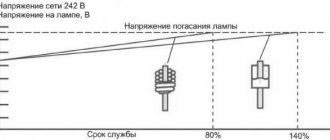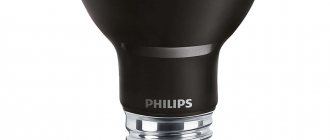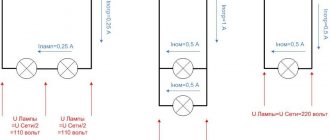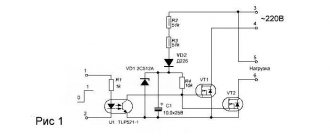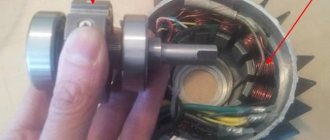What are dimmable lamps and luminaires?
Lamps, regardless of their operating principle, have a certain power, on which the intensity of the luminous flux depends. To increase or decrease the illumination, users have to replace the light bulbs or turn on a certain number of them, if this is provided for by the electrical wiring.
Dimmable lamps allow you to change the luminous flux at any time at your discretion using a dimmer - a direct or alternating current device, which is also called a dimmer or dimmer.
Manufacturers also offer LED lamps - this is a separate group of lighting devices that do not need additional regulators, since the dimmer “filling” is built inside them. The lighting intensity is changed using the remote control or buttons located on the body.
Tips for choosing
In order not to throw money away and not to stumble upon a product that is of poor quality or does not fully satisfy your needs, we suggest using several tips for choosing. The following criteria should be assessed:
- Coating. Lamps come in 2 types of coating – matte and transparent. The former help soften the effects of bright light.
- Power used. Usually this indicator is indicated by the manufacturer on the packaging. Experts recommend purchasing a lamp with a power rating of 11 W.
- Consider the luminous flux indicator. It is necessary for those who are going to install lamps for external lighting, or for it to “work” in a large room.
- voltage indicator. You need it to purchase a dimmer that will work perfectly in combination with an LED lamp.
- directly selecting a product that supports the brightness change option. Its presence or absence is indicated on the packaging, next to the power indicator.
- temperature shade. There are two types of shades on which the light in the room depends - warm and cold. Warm is characterized by light of a yellowish tint, while cold is characterized by white, bright light.
- Of course, the main parameter is the base. Not all lamps have the same base. Due to the fact that each electrical appliance has an individual cartridge, the base is selected based on the type of cartridge.
And now that the main points have been discussed, let's move on to the review.
Types of dimmers
Dimmers are electronic devices that differ not only in design, but also in their operating principle, design and other features. Before buying a dimmer, familiarize yourself with their structure and capabilities.
By installation method
Dimmers differ from each other in the way they are installed. When choosing the type of device, take into account the wiring and interior features.
There are three types of dimmers:
- For outdoor installation. These are overhead devices similar to regular light switches. Inside the device there is a dimmer for LED lamps. Plus - ease of installation. There is no need to drill a hole in the wall; the device is mounted directly on it. External dimmers are convenient in rooms where the interior is not a priority. They are also in demand in rooms with external wiring.
- For indoor installation. You have to make recesses in the walls for them, but they look beautiful in the most presentable interiors.
- For DIN rail. The device itself is placed in the electrical panel, and the power is controlled using a remote control.
By control method
The illumination is changed using different control systems. They all cope well with the task, and the choice of one type of dimmer or another depends mainly on preference.
Brightness controls are:
- Rotary. The simplest mechanical switch. The illumination level is changed by turning the knob clockwise or counterclockwise.
- Rotary and push. In appearance, they are the same as rotary ones, but their design allows you to press the light to turn on the brightness that was set the last time you turned it on.
- Push-button. These models look more modern and fit organically into interiors. The illumination changes after pressing the key.
- Sensory. Available in different designs. The sensors look like circles or rectangular panels.
According to the operating principle
There are dimmers that operate on AC and DC current. The first ones differ in the principle of voltage change.
There are two types of AC dimmers:
- Leading edge cutoff. This is the simplest and cheapest option. For use with dimmable lamps only. The use of dimmers with leading edge cutoff causes interference in electrical networks - this affects the operation of the TV and other sensitive devices. Scheme of work:
- the end of a half-wave is applied to the load, cutting off its beginning;
- a voltage of a given amplitude is supplied to the lamp, which decreases after the sinusoid passes through the zero mark.
- Trailing edge cutoff. Can work with non-dimmable lamps. The adjustment is better - without interference with electrical appliances, but there is one drawback - the illumination of the lamps does not change from zero, but in a certain light range.
Types of modern dimmers
Manufacturers supply the market with a large number of different equipment that can adjust the brightness of the light. Therefore, for convenience, it is divided into types.
First of all, devices are divided according to the type of control, which is as follows:
- Mechanical , sometimes called stationary.
- Electronic - like the previous option, it is a contact type. But instead of regulators and buttons, a sensor is used. This method is modern, effective, informative and quite expensive.
- Acoustic , that is, the brightness of the glow changes as a result of some kind of sound signal that exceeds the noise level set by the user or manufacturer.
- Wireless remote control - a control panel familiar in other areas is used here, as well as smartphones and tablets. In addition, various types of signals can be used, namely infrared, radio.
With a mechanical control method, the homeowner can adjust the brightness of the glow using a push or rotary control - a regulator, buttons, keys. It transmits a signal to a controller installed in the power line.
The task of any modern dimmer is to control the supply of electric current to the power driver of an adjustable LED lamp or a group of them
That is, the procedure is similar to using a regular switch. Some regulators even have controls in the form of familiar keys. This method is effective, simple, and accessible. The only relative disadvantage is the obsolescence of this option, which results in lack of prestige.
The electronic method, apart from being informative, has no other advantages over the mechanical one. But the modern display alone, indicating the necessary information, makes this option more modern and even prestigious, which is the reason for choosing it.
The touch dimmer is the most modern, functional and practical. In addition, it is more aesthetically pleasing, but has a higher cost than a mechanical one, so the latter type is more in demand
Acoustic dimmers are also a popular control method; in addition, they are affordable and reliable. A significant drawback is the limited modes. There are only a few of them and they are pre-installed. Therefore, it is not a fact that they are ideal for the user.
In addition, there is no guarantee that this option will work correctly, since its acoustic sensor will respond to any signal of sufficient power, and this will not always give the expected result. In this case, the user will not be able to constantly monitor the situation.
A dimmer with a rotary control is structurally simple, and therefore the most accessible to a potential buyer. Plus, it's easy to operate
As mentioned above, a wireless remote method for controlling the brightness of LED lamps in a home involves the use of some kind of control panel capable of issuing the command:
- via radio channel;
- via infrared channel.
In the first case, control is possible from anywhere in the room, building, and even from outside. This option is practical and effective, but expensive, since such equipment costs a lot.
The infrared remote control also expands the user's capabilities, but requires pointing at the dimmer. Despite the relative disadvantage, this option is more popular - the equipment is more affordable.
In addition, transmission of commands using smartphones and tablets via Wi-Fi is also considered remote control. Often, such a system is also accompanied by a remote control, which increases convenience.
Today, the remote control method is the most functional, as it allows you to unleash the full potential of dimmers for LED strips, spotlights and conventional lamps. Namely, it makes it possible to use energy as economically as possible and increase comfort to the expected level.
In addition, this option allows you to automatically or smoothly turn off/on the lights, simulate the presence of owners in the rooms, and perform any other functions available to regulators.
A push-type mechanical dimmer is also one of the relatively inexpensive products. In some cases, using keys is more convenient to control, and the aesthetic properties are often higher than those of a rotary analogue
A potential buyer needs to know that today solutions are increasingly being used that can be controlled using several methods at once. This makes the procedure for adjusting the brightness of lamps more reliable and convenient. The only disadvantage of combined control systems is their considerable cost.
Additionally, all dimmers produced today can be divided according to the installation method.
Which are as follows:
- overhead - such devices are installed instead of conventional switches;
- built-in - they are mounted in a distribution box, a specially made niche;
- modular or panel - their place is on the DIN rail in the electrical panel room, but due to their functionality, performance and high cost, such residential devices are rarely used.
You should know that overhead models are the most popular due to their availability and ease of installation. Practice-tested methods for connecting dimmers are given in our recommended article.
Advantages and disadvantages
It’s hard not to be interested in dimmable lamps – the ability to change the lighting intensity looks very tempting. Before you buy such lamps or fixtures, evaluate their advantages and disadvantages.
Pros of a dimmable lamp:
- Selecting the operating mode allows you to use the lamp for both intense lighting and light illumination in the evening.
- Dimmable LED lamps last longer than non-dimmable ones. If the latter are connected to a dimmer, they will quickly burn out due to exposure to extreme loads that their stabilizers cannot withstand.
- It can change the temperature of light transmission, which allows you to change the perception of space.
- Does not emit infrared and ultraviolet rays. Thanks to this, objects, fabrics, furniture upholstery, wallpaper and other things that are exposed to lighting do not burn out.
- Can be used for room zoning. To do this, individual lamps are connected to a dimmer and, by changing the brightness of the lighting, illuminate the desired areas of the room.
Dimmer lamps have much fewer disadvantages
- The main disadvantage is the high cost. Moreover, both the lamp itself and the control switch are expensive.
- There may be difficulties with choosing lamps and dimmers - they must match each other and be compatible. Some manufacturers produce lamps that are compatible only with dimmers of their own production.
- They can interfere with electrical appliances, sometimes flickering, humming and crackling (if the lamps are of low quality).
Advantages of using a dimmer for LED devices
A significant advantage of using a dimmer is the ability to not only save energy, but also create a unique atmosphere with dim light. Or it is advantageous to highlight a certain area of the room by illuminating it with an LED strip controlled by a dimmer.
Regular LED lamps cannot be used in conjunction with dimmers. Their brightness will not change when scrolling the control. The device will only turn on when sufficient voltage is reached at full brightness.
This happens due to the fact that the driver compensates for the occurring voltage fluctuation to the normal operating current of the LED. But in the design of LED dimmable lamps there is a special driver, thanks to which it becomes possible to control the brightness.
Advantages of LED devices:
- efficiency - consumes 90% less energy than incandescent lamps;
- absence of UV and IR radiation;
- long service life of the device - up to 30,000 hours;
- warranty period 36 months;
- high color rendering index.
A long warranty period allows you to recoup the high cost. Dimmable LED lamps that fail prematurely are replaced at retail outlets with new ones, thus achieving even greater savings.
How does a dimmable LED lamp work?
Using dimmable lamps is easy. The user only needs to turn a switch or press a button to change the illumination. The processes taking place in the lamp and dimmer are much more complex.
How scientists “forced” an LED lamp to change the light intensity:
- Response of a non-dimmable lamp to adjustment. When trying to adjust the brightness of a regular lamp, at first nothing changes - the lighting device does not react in any way to turning the dimmer knob. This is explained by the driver program. It has a clear task - to maintain current and voltage values at a given level. If the input voltage becomes too low, the device finally reacts - it simply turns off the diodes (if the lamp is from a good manufacturer) or starts blinking (low-cost products). She “doesn’t understand” how to act.
- Operating principle of a dimmable lamp . The inventors solved this problem by changing the driver circuit. In a dimmable lamp, it monitors the voltage level that is supplied to its input. As soon as it changes, the driver automatically changes the current passing through the LED.
The dimmer changes the consumer's power by adjusting the voltage supplied to the load. The power decreases/increases along with the drop/increase in voltage. This dependence is expressed by the physical formula: P = I * U.
Current (I) and voltage (U) are related by Ohm's law: I = U/R. By increasing the load resistance (R), we reduce the voltage and power of the lamp.
The load resistance is adjusted using:
- resistors;
- capacitors;
- chokes.
The dimmable lamp itself is nothing special. Only in conjunction with the regulator does it acquire new functions. Dimmers operate on semiconductor devices that change resistance.
The operating principle of a dimmer depends on its type. The following dimmers are available:
- Resistive. The operating parameter is formed by changing the resistance of a rheostat or a variable resistor connected in series with the load. Maximum resistance corresponds to minimum current and minimum brightness. The disadvantage of such regulators is the constant power consumption. Because of this, it is not possible to save on electricity with it.
- Triac. Their work is based on the operation of a triac - a semiconductor element that changes the current curve to the required parameters. This is the best option for light regulation, as it allows you to save on lighting by reducing the intensity of the light flux.
Triac dimmers, unlike resistive ones, regulate not only brightness, but also color temperature.
Do dimmers save energy?
Another myth is that you save energy when using dimmers. This primarily applies to incandescent lamps.
Most users still believe that if you leave regular incandescent light bulbs in the lamp and turn the dimmer down to 50%, then you will pay 2 times less for the light. This is not entirely true.
To reduce the brightness of an incandescent lamp by half, you need to reduce the voltage by about 80%. In this case, the current strength will decrease slightly due to the nonlinear resistance of the filament.
The actual power consumption of the lamp in this case will be 75-80% of the original. You will receive 2 times less light, and save only a measly 20%.
Therefore, the only real savings are achieved not by dimming, but by replacing simple lamps with LED ones.
Operation of dimmable LED lamps
To ensure that dimmable lamps serve properly and for a long time, use them correctly. If you choose and connect the LED light bulb correctly, there will be no problems with its operation.
Connection diagram
The way in which adjustable LED devices are connected to a circuit with a dimmer depends on the voltage they are designed for.
Inclusion options:
- Lamps for 220 V. The dimmer is installed in the open circuit of the load (lamp).
- Lamps for 12 and 24 V. In this case, a power supply is placed between the low-current dimmer and the network.
The dimmer itself has dimensions and mountings identical to a standard light switch, and is installed in the same way - placed in a mounting recess or mounted on the wall, depending on the design.
To realize the idea of adjusting the brightness of lighting, it is enough to replace a regular switch with a dimmer. This is not difficult to do. Both devices have 2 terminals that connect to the same wires to which the switch was connected.
When connecting a dimmer, polarity is not important. But if you have a phase indicator screwdriver and it is possible to determine the phase, it is recommended to connect the phase wire to terminal L (as required by the manufacturer).
Brightness adjustment
Dimmable lamps have a special driver that performs pulse width modulation. This device changes brightness from 5 to 100%. The illumination intensity is adjusted by changing the length and frequency of the pulse. The third parameter – amplitude – remains unchanged.
The brightness is switched mechanically or by touch - it depends on the type of dimmer. In any case, comfortable and smooth adjustment of the lighting level is ensured.
Life time
The service life of dimmable LED lamps is influenced, first of all, by the manufacturer. On average, they can burn from 15 to 40 thousand hours.
Factors influencing service life:
- Indoor microclimate. Lamps last the longest at moderate temperatures and humidity.
- Base. Models that have ventilation holes in the base have a longer service life.
- Circuit. The service life is reduced due to voltage surges and poor-quality wiring.
- Connection. Lamps last longer if they and the dimmer are properly connected to the network.
- Quality. Low quality products last less. Service life can also radically reduce manufacturing defects.
Criterias of choice
Manufacturers indicate a fairly wide range of parameters for lamps. Therefore, when choosing dimmable LED devices, you need to carefully study their characteristics, because subsequent replacement will result in significant costs for you.
- Flask shape
The direction of the flow and the possibility of installing it in a particular lamp will depend on the shape of the dimmable lamp. The following options should be highlighted:
- ball or mushroom - give a diffuse flow, which can change due to the light transmittance of the material or the presence of a reflective coating;
- spot – provide local illumination in a certain area;
- tubular - illuminate an extended space, for example, a shop window or corridor;
- decorative - create room decoration along with lighting.
A wider division by shape is shown in the figure below for clarity:
Rice. 3. Lamp shape
- Power
Determines the amount of electricity consumed from the network. For LED lamps, in comparison with classic options, this parameter is the most economical.
If compared to the same fluorescent or incandescent lamps, they consume several times less kilowatts to produce the same luminous flux. For example, 10W LED devices are equivalent to a 100W incandescent light bulb, which should be taken into account when choosing a device.
- Voltage
The rated voltage of the dimmable lamp can be 220 or 12V. But it is much more interesting for domestic citizens to focus not only on the nominal value, but also on the permissible operating limits.
For example, a dimmable lighting fixture can function normally within an operating voltage range of 170 to 240V. Therefore, if the voltage in your networks drops below 170V, you will need a different model.
- Base
There is a wide variety of sockets, but dimmable lamps most often use E or G. The first of them represents a classic thread that screws into a socket, and the numbers following the marking indicate the diameter in millimeters.
For example, an E27 socket or an E14 socket indicates that these bulbs can only be installed in sockets of the appropriate size. The G marking differs from standard sockets in that the contacts are represented by two pins that must be inserted into the corresponding slots in the socket.
Rice. 4. Base type
- Manufacturer
The quality of the device and its compliance with the declared parameters directly depends on the manufacturer, so preference should be given to trusted companies. Let us note that Philips and Uniel have proven themselves quite well.
Separately, Gauss lamps should be noted, since the manufacturer produces not only ordinary dimmable lamps, but also models that produce different levels of light from a regular switch - they respond to the number of key presses.
Why can't regular lamps be used with a dimmer?
Ordinary lamps cannot be connected in the same circuit with a dimmer. It's all about the design. A simple LED lamp has a micro-rectifier that converts the input AC voltage to DC. A regular LED light bulb can only be in two positions - on or off.
A dimmer assumes a completely different approach to lamp operation. With its help, a smooth and gradual change in the level of illumination is carried out. If you screw an ordinary, non-dimmable lamp into a circuit with a dimmer, it first blinks and then turns on 100%.
If the lamp burns at full power in the same circuit with the dimmer, both devices become unusable after a short time. Inside dimmable light bulbs there is a special unit through which the brightness is adjusted.
What advantages does the regulator provide?
As stated above, dimming primarily reduces energy consumption. This reason is already enough to connect it to LED lamps in the home and any other premises. But there is a whole list of advantages.
These include:
- The ability to change the intensity of the glow provides owners with increased living comfort and helps make any interior individual and exclusive. So, for example, a room can be divided into separate zones using lighting. It will also be possible to change the brightness depending on the time of day and needs.
- Simulating the presence of owners in the premises - this option will be indispensable during vacations or business trips, which will make it easy to mislead burglars.
- Automatic switch-off/switch-off - modern dimmers can be programmed, in addition, they can be controlled by various external devices, for example, tablets, smartphones. There are special signaling devices that send commands to power drivers.
All kinds of preset lighting and blinking modes allow you to select the best options for any time of the day once and not waste time in the future. In addition, it is not only convenient, but also allows you to save more.
The picture shows a regular sinusoid of electric current; it is in this form that it is supplied to LED lamps, but dimming in this case is impossible
Remote control is also an important advantage. With its help, a person can regulate the voltage, and, consequently, the brightness of the glow, in various ways, for example, using a remote control, radio and sound signals (claps, voice).
At the same time, modern regulators themselves are durable and unpretentious. In addition, they are convenient to use.
You also need to know that with their help you can control LED lamps with familiar standard sockets, for example, they can be the familiar E27, E14, as well as many other popular and rare ones. This greatly simplifies the creation of the system.
It is also important that dimmers are able to control the glow of one lamp, several or even a whole group. They are resistant to overloads, silent when the model is correctly selected, light in weight, and compact.
This is again a current sinusoid, but if you compare it with the previous picture, you can see that it is significantly “cut off” - that is, short pulses with long pauses are the result of dimming
The cost of such equipment varies, so the interested consumer will be able to choose the optimal solution according to his budget, which will ensure the expected result.
How to choose the right quality dimmable lamp?
The dimmable lamp has the same design as its conventional counterparts. It consists of a diffuser, a radiator and a base. They screw into standard cartridges.
Lamp characteristics
Stores sell dimmable lamps that differ from each other in a variety of parameters. When buying LED lamps, you cannot focus only on appearance, manufacturer or price. Today there are a lot of models of LED light bulbs on the market, and not every consumer will immediately understand them.
Characteristics:
- Operating voltage. Its fluctuations in the network can exceed the critical 230 V. In order for the lamp to work stably, it is desirable that it be designed for the widest possible range - 170-260 V.
- Supply voltage. There are products on sale for 220, 12 and 24 V. Lamps with a voltage of 12/24 V are intended for lamps that have voltage converters.
- Colorful temperature. The color of the light flux depends on this parameter - it can be yellow or white. The first one is considered warm, the second one is considered cold. At a color temperature of 4-5 thousand Kelvin the light is white, at 2.7-3 Kelvin it is yellow.
- Light flow. It is measured in Lumens and determines the brightness of the lamp. The indicator varies between 200-2,500 Lumens.
- Color rendering index RA. Determines the uniformity of the color elements of the light flux. With low RA values, it is difficult to distinguish shades of colors. The higher it is, the less strain on the eyes.
- Power. Manufacturers produce products from 1 to 25 W. The higher the power, the more intense the lighting.
- Base. Today you can buy a dimmable lamp with all types of bases found in conventional analogues. Types of bases: E27 – standard base, which is used in chandeliers and lamps installed in residential premises;
- E14 – used in floor lamps, chandeliers, sconces, lamps;
- GX53 - for lamps and luminaires installed in rooms with high humidity levels;
- G9 – for luminaires used in spot lighting;
- GU10 - for decorative lighting.
When buying light bulbs, pay attention to their shape and dimensions. They must fit not only the base, but also the size of the shades, chandeliers and lamps.
Differences between a dimmable light bulb and a regular light bulb
In appearance, dimmer lamps are the same as conventional LED light bulbs. If you put two LED lamps next to each other - dimmable and non-dimmable - it is impossible to distinguish them.
Miniature devices that change the luminous flux are located inside the lamp. The dimmable device is recognized only by its markings. The packaging must bear one of the following inscriptions/icons:
- "dimmable";
- "dimmable";
- image of a rotary dimmer knob.
If the lamp says “not dimmable”, it is not suitable for adjustable lighting.
Risks when purchasing
If the buyer does not have experience using dimmable LED lamps, do not rush into the purchase. The main risk when purchasing is purchasing a model that is incompatible with the already installed dimmer. Many buyers do not have the opportunity to understand in advance whether a lamp is suitable for a dimmer or not.
Tips for those who are going to buy an LED lamp:
- Agree with the seller about the possibility of returning the product if its parameters turn out to be unsuitable.
- Take light bulbs from well-known manufacturers - this increases the chances that they will match the characteristics of the dimmer.
- Do not take low-power lamps up to 10 W. They cost less, but provide low light output, a small range of adjustment and “cold” lighting, which is unpleasant for the eyes.
- Pay attention to the base so that it fits the cartridge. There are threaded and pin sockets. Check this point and find out what diameter of the base you need.
For those who do not know how to select a light bulb according to its parameters, it is recommended that you first read the technical documentation for the dimmer and lamp. The shopping center's consultants also help you make the right choice.
Rating of LED lamps in the form of candles
Gauss 103101107 – D
Pay attention to the base, it is also different from the classic one, its type is E14. The power setting is 7 W, which allows you to illuminate a room with an area slightly larger than 3 sq.m. The light of the lamp is warm, and the bulb is matte. Gauss has specified a service life of 35,000 hours for this model. Just like all the samples in this review, it supports paired operation with a dimmer, which allows the user to change the level of illumination in the room.
The average price is pleasant. Due to the stated characteristics, this dimmable LED lamp is sold from 250 rubles.
Gauss 103101107 – D
Advantages:
- excellent degree of illumination;
- manufacturer guaranteeing good quality;
- The lamp is energy saving.
Flaws:
- not identified
Lighting E14 8W 2700K
It is logical to assume that it supports dimming. The glass of the flask is transparent, and the reproduced color is warm white. The base is non-standard, pay attention to this factor when purchasing. Long lifespan.
You can buy it at an average price - from 100 rubles.
Lighting E14 8W 2700K
Advantages:
- price;
- The lighting quality is excellent.
Flaws:
- not identified.
FERON LB-69,C35T
What immediately catches the eye and will certainly interest the consumer is the unique shape of the flask. It is made in the shape of a candle, but an unusual one, the flame of which sways in the wind. Let's say that this is an extraordinary design decision. Speaking about the parameters of the model, we note the large dispersion angle of 300 degrees, and this allows us to avoid the occurrence of areas that will be darkened. This is possible when the lamp is positioned in a horizontal plane. Technically, the manufacturers have provided a heat sink that can be called efficient due to the materials used. This parameter ensures reliable and high-quality use.
The price for this sample is, frankly, amazing - only 60 rubles.
FERON LB-69,C35T
Advantages:
- attractive flask shape;
- low price;
- reliable use.
Flaws:
- low power level.
Feron LB-166
Has an atypical base. A transparent bulb, white warm light and a power of 7 W, can organize an excellent bright space, both in residential premises and in areas where office work is organized. Operates from a network with average voltage.
The price per unit of goods is set on average from 200 rubles.
Feron LB-166
Advantages:
- good level of power;
- acceptable price.
Flaws:
- not detected.
Navigator 61380
Here the manufacturer is China. For her, it was decided to choose a flask with a matte finish. The model is characterized by long-term and high-quality operation, which cannot but please consumers. Connects to a dimmer.
The average price is 220 rubles.
Navigator 61380
Advantages:
- pleasant color lighting;
- Flicker is excluded.
Flaws:
- not identified.
OSRAM Parathom Classic B 40 Dim 827
Sample made in Germany. The glow is chosen to be white and warm. Experts recommend using such lamps in rooms where high-quality lighting is provided. This model copes well with the “responsibilities” assigned to it. If this room is small in area, then its technical parameters can be perfectly revealed. A non-standard base is used. Brightness parameters can be adjusted using the device we described earlier. But it’s impossible to be clear about the period of use. And this parameter can perhaps be classified as average.
The price starts from 120 rubles.
OSRAM Parathom Classic B 40 Dim 827
Advantages:
- low price;
- the lighting is pleasant to perceive;
- quality and reliability.
Flaws:
- short service life.
What are the problems at work?
Problems may arise when using dimmable LED lamps. To eliminate malfunctions, you need to know the reasons that caused them.
The lamp is not adjustable in the power range of 10-15%
The light flux emitted by the LED lamp can be reduced to 10% of the maximum. If you cannot change the brightness level in the range from 10 to 15% of power, then the cutter is of low quality. The second option is that the dimmer is not suitable.
The solution to the problem is to buy high quality products from well-known manufacturers and with a minimum threshold for switching on and off.
Flicker
If the circuit uses a switch that has an indicator light, the light bulb will begin to flicker when the light is turned off. The solution to the problem is to turn off (remove) the indicator or install a new switch.
Another possible reason for the flickering of a dimmable lamp is a driver failure. In this case, the light bulb needs to be replaced.
Buzzing
If the light bulb makes an unusual sound, it means that it and the dimmer are incompatible in various respects. Due to device mismatches, the lamp may not only hum, but also turn on/off from time to time. The solution to the problem is to replace the dimmer or LED lamps.
Another reason for the hum is a driver failure. In this case, you also cannot do without replacing the lamps.
Dimmer is not suitable for 220 V network
If the 220 V lamp is of high quality, any dimmer model for a standard network is suitable for it. If the dimmer is cheap and of low quality, it may not cope with the assigned tasks.
To avoid problems, a dimmer is purchased after consultation with a specialist or after testing it in operation.
Advantages
The dimmer used for LED lamps has several positive aspects:
- With its help you can save energy.
- By controlling the brightness of the lighting, you can emphasize the most advantageous areas and places in the rooms (panels on the wall, floor composition, etc.), which improves the design of the entire interior.
- The load can be changed smoothly.
- The most important advantage is the comfort of the light mode at any time of the night or day.
- Increasingly, a dimmer for LED lamps is used as a watchdog device. You can set a special program with which the lamps will turn on and off at different times in individual rooms. This will create the illusion that someone is present at home. It is very convenient to protect your household from uninvited guests this way if you need to leave for several days. All this is possible due to the fact that dimmers are able to support dimming and blinking modes.
- Such a regulator will serve as protection against overvoltage in the network.
- Since the regulator saves the electrical life of the lamp, this helps to extend its service life.
You see how many good and useful functions such a device performs. So, despite the complexity of its connection diagram, high cost, and the need to reinstall existing wiring elements, it is still worth spending money on a dimmer.
The most popular manufacturers
When buying LED lamps, pay attention to the manufacturer. This allows you to purchase high-quality products with a long service life. There are several well-known brands on the domestic market offering high-quality lamps.
Osram
This German company is known throughout the world as a manufacturer of high-quality lamps, luminaires and other lighting equipment. It produces LED lamps in a wide range, with sockets of different types and sizes.
Lamps with E14 and E27 sockets are produced in the form of balls and candles; they are used in chandeliers, floor lamps, and lamps.
Pros:
- high color rendering coefficient - above 80;
- large selection of lamps;
- excellent performance characteristics, including inexpensive models;
- efficiency.
The disadvantages of Osram products include:
- high cost;
- possibility of marriage.
Philips
Dutch world famous company producing lighting equipment. The brand uses innovation and produces products with a long service life - up to 40 thousand hours.
Pros:
- maintaining brightness with a long service life;
- high energy efficiency;
- safe for vision due to specially set temperature parameters and lack of flicker;
- wide selection of lamps;
- There are models in which the color temperature is adjustable.
Minuses:
- high price;
- small dispersion angle for inexpensive models.
Gauss
Domestic Gauss lamps are distinguished by a wide input voltage range (185-265 V), which expands the possibilities of their use in areas with unstable power supplies and low-quality electricity supplies. Lamps with predominantly rich, bright white light.
Pros:
- high color rendering index – reaches 90;
- long service life - up to 50 thousand hours (if translated into everyday use, the lamps last about 35 years);
- warranty periods – 3-7 years;
- beautiful design, suitable for modern interiors in high-tech style and others;
- There are many models with switchable lighting temperature.
Gauss presents a series of lamps that implement the principle of step dimming. They do not need a dimmer - it is built into the lamp.
Minuses:
- are expensive;
- rarely sold in stores (must be ordered online);
- not compatible with many switches and dimmers - you have to check for compatibility before purchasing.
Uniel
Another domestic manufacturer whose Crystal and Palazzo series are especially popular. The lamps from this company are universal and work with almost all AC dimmers. They have a matte bulb and a standard base, like conventional incandescent lamps. They operate in the range of 175-250 V.
Uniel lamps are sold in all major stores. Previously, they were produced in China, and recently they opened a factory in Russia, which produces the most popular models - pear-shaped lamps with an E27 base. Service life – 30 thousand hours. All products have a three-year warranty.
Pros:
- high color rendering – up to 80;
- wide range of models;
- moderate cost;
- do not reduce brightness when the voltage drops to 133 V.
Minus - they do not work with switches equipped with indicators.
Dimmable lamps allow you not only to adjust the lighting to your needs, but also save energy. The main problem is the incompatibility of devices. To avoid this, carefully study the technical parameters of lamps and dimmers before purchasing.
Dimmer compatibility with different types of lamps
It is worth understanding why, when purchasing a whole set of elements for a control system, there is a need to select them for each other. If the selection is incorrect, they simply may not make money together. This can happen for a number of reasons:
- A huge variety of adjustment devices and electronic circuits are available on the market. Manufacturers from different countries have their own voltage threshold; often it may be incompatible with other manufacturers, due to this the adjustment range is reduced. This may affect the comfort level of lighting.
- It may happen that the lamp or the power driver in the LED lamp will not turn on at all, and may also begin to make extraneous sounds.
- There is a possibility of not using the full power of the light bulb due to the fact that the output dimmer does not provide the required 220 Volts.
- Intermittent flashes of the lamp may appear, like flashing.
- There are failures in the adjustment mechanism itself, which prevents the lamp from being controlled in a timely manner.
These are possible consequences of incompatibility of the dimmer, lamps and LED lamps, which should be taken into account when choosing.
To reduce the likelihood of misalignment, it is best to further study the information about the LED lamps and dimmers themselves on the packaging and in the manufacturers' instructions. You can also contact the consultants in the store and ask them about compatibility; they have not only theoretical, but also practical experience and can give you useful recommendations.
Installation of dimmers
Conventional lamp switches are not compatible with dimmable LEDs because they interrupt the input voltage but do not affect the lamp's light output (no dimming or dimming).
The optimal setting would be to connect only one fixture to the dimmer to avoid flickering lights that could damage or burn the dimmer.
- Be sure to turn off the power to the system before doing any work, and if you don't have the skills to install it yourself, your best option is to contact an electrician.
- The installation procedure is not very complicated, you just need to have a screwdriver of the appropriate size and shape, disassemble the electrical plates and disconnect the 3 wires or phase, neutral and ground by removing them from the old dimmer.
- Next, you will need to reconnect the wires in the same order, screwing it into the appropriate space and closing everything.
Now try running a few tests to make sure you don't hear any strange noises like vibrations or problems with flickering or glare from the light emitted. If you don't hear any noise or see visual interference, then the dimmer is set correctly.

